#st Colmcille
Text

St Colmcille - Translated by Seamus Heaney
6 notes
·
View notes
Photo

On this day, August 22, 565 St Columba reports seeing monster in Loch Ness. The first recorded sighting of the Loch Ness Monster.
Columba or Colmcille (7 December 521 – 9 June 597 AD) was an Irish abbot and missionary evangelist credited with spreading Christianity in what is today Scotland at the start of the Hiberno-Scottish mission. He founded the important abbey on Iona, which became a dominant religious and political institution in the region for centuries. He is the patron saint of Derry. He was highly regarded by both the Gaels of Dál Riata and the Picts, and is remembered today as a Catholic saint and one of the Twelve Apostles of Ireland. Columba studied under some of Ireland's most prominent church figures and founded several monasteries in the country. Around 563 AD he and his twelve companions crossed to Dunaverty near Southend, Argyll, in Kintyre before settling in Iona in Scotland, then part of the Ulster kingdom of Dál Riata, where they founded a new abbey as a base for spreading Celtic Christianity among the pagan Northern Pictish kingdoms. He remained active in Irish politics, though he spent most of the remainder of his life in Scotland. Three surviving early medieval Latin hymns may be attributed to him.
As for the “monster”, in the 1960s several British universities launched sonar expeditions to the lake. Nothing conclusive was found, but in each expedition the sonar operators detected some type of large, moving underwater objects. In 1975, another expedition combined sonar and underwater photography in Loch Ness. A photo resulted that, after enhancement, appeared to show what vaguely resembled the giant flipper of an aquatic animal.Further sonar expeditions in the 1980s and 1990s resulted in more inconclusive readings.
58 notes
·
View notes
Text
Medieval Ireland | Inishmurray Monastic Site
Medieval Ireland | Inishmurray Monastic Site
“Saved by its ocean walls from ordinary marauders in former times, and from the wanton tourist of today… Inishmurray has retained a larger number of examples of primitive Irish Art than perhaps any other early Christian settlement in Ireland.” ––William Wakeman, A Survey of the Antiquarian Remains on the Island of Inishmurray, 1893
The first people to settle on what would be known as Inishmurray…
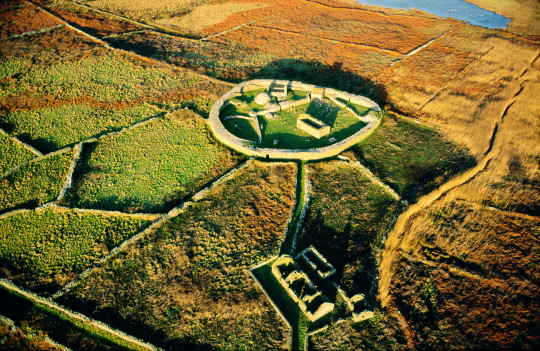
View On WordPress
#Caiseal#Cashel#Christianity#Co. Fermanagh#Co. Sligo#Curing Stones#Cursing Stones#Devenish Island#Inisbofin#Inishmurray Monastic Site#Laisrén mac Decláin#Leachta#Lough Erne#Medieval Ireland#Monks#Rathlin Island#St Colmcille#St. Molaise#Vikings
21 notes
·
View notes
Note
St. Colmcille! The forgotten middle child of Irish patron saints and also the Irish saint with the coolest name. Patron saint of floods and bookbinders (multi-tasking slay). My bestie frfr
AKA St Columba!!!!!
Another vote has been added for him!!
6 notes
·
View notes
Text
ST COLUMBA'S CHURCH AND ROUND TOWER
The parish of St Colmcille’s Swords, has an interesting history extending right back to the 6th century. It was St Colmcille who brought Christianity to the area circa 560 AD.

View On WordPress
#2016#april#building of interest#Christianity#church road#County Dublin#Fotonique#graves#Graveyard#historic#Infomatique#landmark#medieval church walls#round tower#square clock tower#st Colmcille#st columba&039;s#swords#Tourist Attraction#William Murphy
0 notes
Text
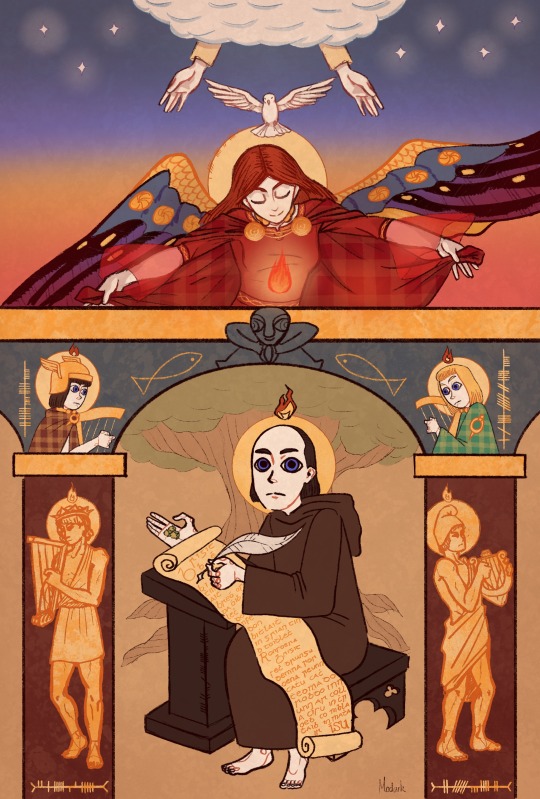
The Bardic Tradition
I made a long thread explaining in detail all the symbolism in this piece when I first posted it. That's lost to time now, thanks Elon. I'll try to rewrite it to the best of my ability in an abridged form.
The basic gist is that its a visual representation of the ancient Gaelic bardic tradition. Seated in the center is St. Colmcille, composing an old Irish hymn to St. Brigid, "Brigit bé bithmaith". He is holding hazel nuts, symbols of knowledge / inspiration in Irish legend. On the two pillars on either side of him are King David (left) and Orpheus (right), two famous poets from antiquity. Two legendary poets from Irish legend, Oisín and Amergin, are situated above each pillar respectively. The two fish are seen swimming "upstream" (as in the legend of the Salmon of Knowledge) toward a sheela na gig, a architectural feature / grotesque of early Irish churches which some consider to be symbols of femininity, meant to ward off evil. At the top of the image, hands from a cloud (representing God) release a white dove (representing the Holy Spirit) down to St. Brigid. She owes her angelic appearance to her being considered both a pagan goddess and Christian saint. She is guarding a flame, which symbolises poetic inspiration, and which can be seen floating above the heads of all the other figures.
#celtic#irish#poetry#celtic mythology#irish mythology#irish culture#ireland#celtic culture#celtic christianity#druidry#druidism#bardic inspiration#imbas#imbas forosnai#celtic revival#gaelic#st brigid#saint brigid#mythology#digital art#mediaeval#medieval art#medieval manuscripts#illuminated manuscript#celtic design#irish history#awen#esotericism#spirituality#paganism
16 notes
·
View notes
Text
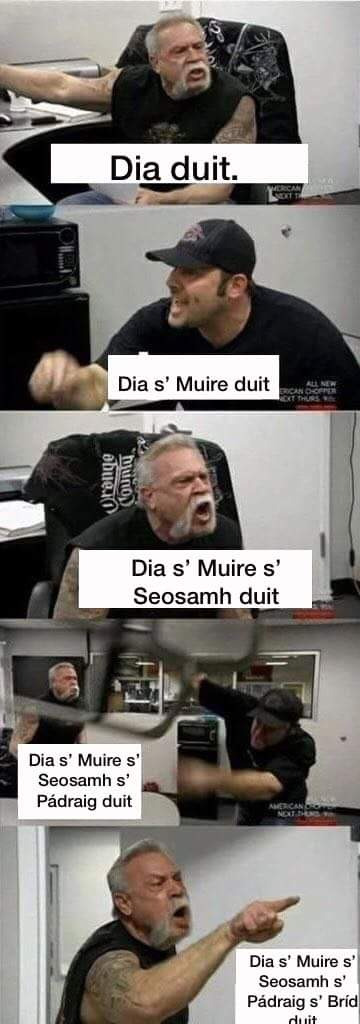
Few people know that the stereotype of Irish people fighting all the time comes from a long history of one-upping each other when saying hello frequently ending in fisticuffs by the time they got to St. Colmcille
81 notes
·
View notes
Note
✨🍀 re: wow toons (idk what that is so pls enlighten me!)
AHAHAHA YES!!!! <-sicko voice
✨- How did you come up with the OC’s name?
🍀 - What originally inspired the OC?
these go hand in hand so i'm doin' 'em together >:3c so wow toons are what you call your different world of warcraft characters, of which i have... 12? 15? some multiple of three. i shall describe each of them in turn bc you've inadvertently activated my trap card.
Sétanta - my very first wow character. he's a worgen bc obviously i'm going to pick the werewolf race, come on. i made him a druid bc i heard you could turn into even more animals and this pleased me. He's named for Cú Chulainn (Hound of Culann), who renamed himself that as a kid. I pronounce it 100% wrong, with an /s/ at the start and a /t/ in the middle, but that's what happens when you learn all your words by reading as a small child. i pronounced seamus See-Miss until i was like 16. it could be worse.
Seidrin - As I was fleshing him out i accidentally went way too hard on his mom's backstory, so when I wanted to make a tank she was the natural choice. her dad is the wolf god Goldrinn, who I decided (fancifully) to pretend was named for galdra, one of the kinds of norse magic. -inn being the masculine name suffix, i changed it tothe feminine -in and named her for seiðr magic instead. went with a d instead of a th bc logan very wisely pointed out the "-drin-" mirrors Goldrinn.
Crimthann - Sétanta's dad. I wanted to make a healer and I was like you know what would be really funny? If I named his dad after another guy who renamed himself for an animal. And Crimthann (an old irish name meaning 'fox') is often alleged to be the birth name of St. Colmcille, 'church dove'. so i made him a priest but unfortunately priests are very boring to play so he's... languishing.
Donn - I wanted to make a Horde character but I didn't know how to play anything but a druid so I was like... surely, this will work. I was gonna name him Donn Cúailnge after the Brown Bull of Cooley but it turns out you can't put spaces in the names. But Donn (shockingly) wasn't taken so... here he is! Tauren druid!
Jettion - I was bullied into making a dracthyr, the newest race, bc they have a fun starting quest. Dragons in wow have name suffixes according to their 'flight' (color) and he's a male black dracthyr (who are like anthro dragons) so his name had to end in -ion, and often the black flight's names start with shades of blade, so... it was either Jetion or Jettion, and I liked Jettion better bc it looks like Jettison.
Shannock - We all made vulpera, the little fox people together. but i'd already used the name Crimthann. so I was like 'maybe sionnach'? but if you can believeit some bastard already snagged it. so i went with a rough anglicization. i should play him more.
Lokworg - I've twice been bullied into making a monk bc supposedly they get fun later on & i just need to keep doing quests with my pals, but my pals are much faster than i am and outstrip me quickly. The first monk i deleted bc i don't care about him and honestly lokworg's not doin' much for me either. His name's orcish, lok is song/cry (noun) and worgs are the large, extra smart wolves orcs ride as mounts. More or less 'direwolf song'.
Rumpelteazer - Peer pressured into doing the worgen starting quest & I wanted someone who could learn to pick locks one day, so rogue it was! Originally named Scátha (irish for shade but also kind of an oblique reference to scáthach, the scottish warrior woman who trained Cú Chulainn (and my own pseudohistorical ancestor)), but I kept pronouncing it wrong and was listening to Cats 1998 soundtrack and... well... he's a rogue! and Mungojerrie was taken!
Ulfhedrinn - in keeping with the norse theme, he's named after the Ulfheðnar (singular Ulfheðinn, wolf+what's basically a hooded vest made of fur) that were an appropriately lupine variety of berserkers. I wanted to make a Horde healer and i was like you know... i haven't made this insane little family big enough yet.
Galdrulf - Okay, honestly? He was supposed to be Ulfhedrinn. We were starting with new Horde characters and we were gonna level together, but I got so lost in the customization sauce that I forgot Ulf's particular flavor of orc starts at level 10 instead of 1. So I panicked and made a warrior, and I named him galdr+ulf bc I'm not very creative under pressure.
Fuil - Bullied into making a dark iron dwarf but i'm not clear on why bc we never got farther than unlocking them? guys? are we doing anything with these? irish for blood bc he's going to be a Blood Death Knight. one day. probably.
Tigernmas - I was peer pressured into making a Demon Hunter, whom I wanted to name Crom but noooo, that was 'taken', so I named him after a pseudohistorical king that got himself and 75% of the men in Ireland killed worshipping Crom Cruach.
you know i'm sensing some themes here. a lot of irish. a lot of peer pressuring. jesus christ is seidrin my only woman? she doesn't even use the fpose model no wonder they keep he/himming me
#long posts#sorry i got excited#answers#howlydoodledoo#thank you i was mentally begging someone to ask me about the etymology. won't somebody ask me about the ETYMOLOGY#world of warcraft
4 notes
·
View notes
Text
8th June
St Columba’s Day
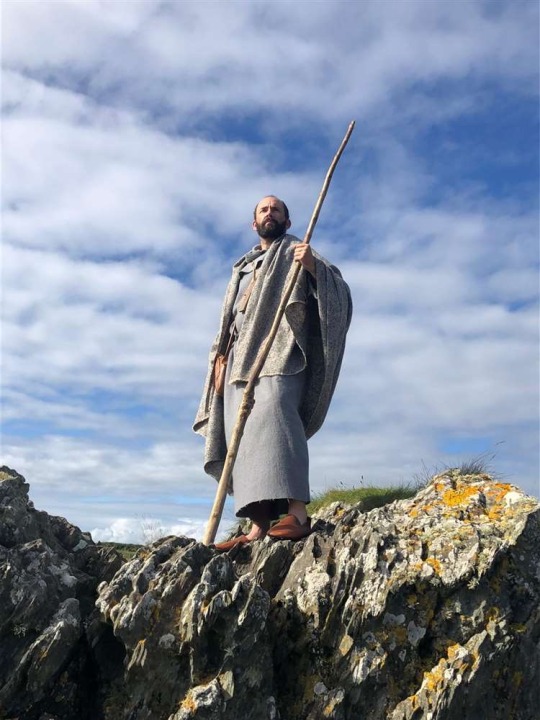
Colmcille (St Columba) on High. Source: BBC Alba and The Northern Scot website
Today is St Columba’s Day. Despite his saintly title “The Dove of Peace” (Colmcille in Gaelic), Columba had a somewhat violent temperament. A dispute over the authorship of a Psalter with a fellow cleric in his native Ireland led to an actual battle between their respective bands of followers, until the Irish Church intervened and sent Columba off to Scotland to convert the still pagan Picts to Christianity. But bad temper and violence accompanied even his missionary work. Slipping on a flounder one day, Columba is said to have cursed the unfortunate fish, leading to its lopsided appearance. He also dealt with a lecherous Pictish noble by “smiting him with an Angel”. Whereas his victim was suitably stunned, the fate of the angel projectile is not known.
Columba’s most famous exploit was rescuing his followers from the Loch Ness Monster, who in an early fifth century appearance, reared threateningly above two of the saint’s disciplines who were attempting to cross the loch in a small boat. Columba ordered the creature not to harm the men and it slipped away under the surface of the lake and has not harmed anyone since. Columba was a highly successful missionary and based himself on the island of Iona where he developed an almost cult like status.
Apparently Columba wore the flower of St John’s Wort to ward off evil. Apparently it still works.
17 notes
·
View notes
Text

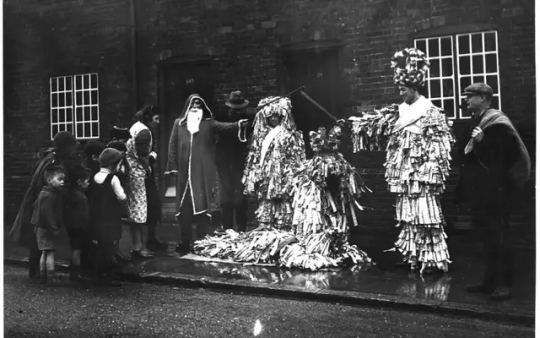

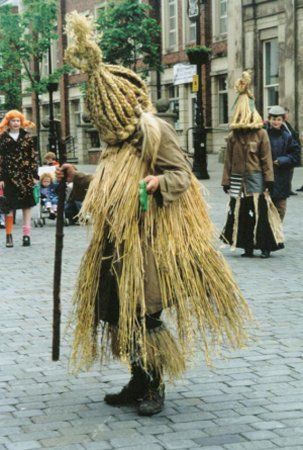

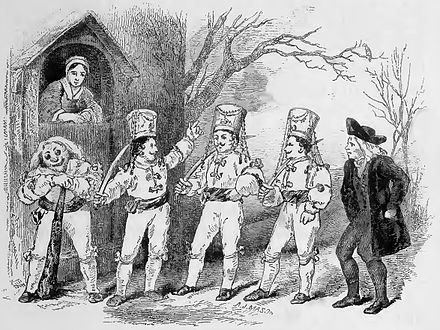
Mumming/Mummering & Mummers' Plays:
Mumming, Mummering or Rhyming is a Christmas tradition originating from England and Ireland, in which large groups will disguise themselves and visit local homes, requesting to be invited in. Their hosts must then guess their identities, after which the Mummers will perform songs, dances and jokes, and receive food and drink from the house.
Mummers' Plays, loosely associated with Mumming, are performed by all-male amateur troupes. Also traditionally done at Christmas-time, performers will visit different houses and act out comic plays consisting of various historical and stock characters. Main characters usually include Prince George, The Doctor, Miss Funny, Beelzebub and The Captain. In Ireland historical figures such as St Colmcille, Brian Boru, Saint Patrick, and Oliver Cromwell often also feature.
1 note
·
View note
Text
Ding dong bell, salmon's in the well
Feast of St Machar or Mocumma, disciple of Colmcille and evangelist of Strathdon. He is said to have founded Old Aberdeen, choosing the site because the bend of the River Don there resembled a bishop's crozier; he has a holy well hard by the cathedral there, whose water was used for baptisms. From another well at Corgarff, he is said to have miraculously drawn salmon in time of famine, and bestowed healing powers upon the waters.
0 notes
Photo

Saint Columba of Iona (521-597) Apostle of the Picts, Apostle to Scotland, Abbot, Missionary, Evangelist, Poet, Scholar and Writer – born on 7 December 521 at Garton, County Donegal, Ireland and died on 9 June 597 at Iona, Scotland and buried there. Patronages – Derry, against floods, bookbinders, poets, co-patron of Ireland and of Scotland. St Columba is also known as Coim, Colmcille, Colum, Columbkill, Columbkille, Columbus, Columcille, Columkill, Combs. Additional Memorials – 6 January as one of the Twelve Apostles of Ireland, 17 June translation of relics. Well-born, handsome and educated, Columban was torn between a desire for God and easy access to the pleasures of the world. Acting on advice of a holy anchoress, he decided to withdraw from the world. His family opposed the choice, his mother going so far as to block the door. He became a Monk at Lough Erne and studied Scripture extensively, writing a commentary on the Psalms. He then became a Monk at Bangor under abbot Saint Comgall. In middle age, Columban felt a call to missionary life. With twelve companions (Saint Attala, Columban the Younger, Cummain, Domgal, Eogain, Eunan, Saint Gall, Gurgano, Libran, Lua, Sigisbert and Waldoleno) he travelled to Scotland, England and then to France in 585. The area, though nominally Christian, had fallen far from the faith but were ready for missionaries and they had some success. They were warmly greeted at the court of Gontram and king of Burgundy invited the band to stay. They chose the half-ruined Roman fortress of Annegray in the Vosges Mountains for their new home with Columban as their abbot. Columban always enjoyed being in the forests and caves and as he walked through the woods, birds and squirrels would ride on his shoulders. Toward the end of his life came word that his old enemies were dead and his brothers wanted him to come back north, but he declined. Knowing that his time was almost done, he retired to a cave for solitude and died as he had predicted. https://www.instagram.com/p/CelgIbsrgWo/?igshid=NGJjMDIxMWI=
0 notes
Text
Medieval Ireland | Inishmurray Monastic Site
“Saved by its ocean walls from ordinary marauders in former times, and from the wanton tourist of today… Inishmurray has retained a larger number of examples of primitive Irish Art than perhaps any other early Christian settlement in Ireland.” ––William Wakeman, A Survey of the Antiquarian Remains on the Island of Inishmurray, 1893
The first people to settle on what would be known as Inishmurray…
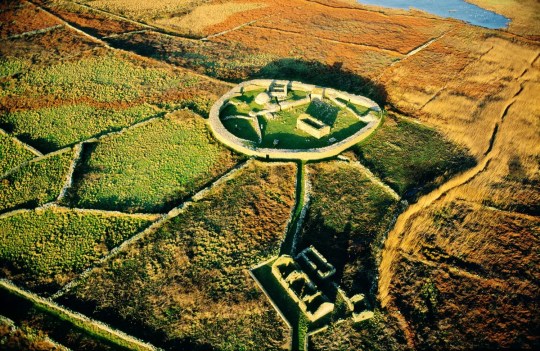
View On WordPress
#Caiseal#Cashel#Christianity#Co. Fermanagh#Co. Sligo#Curing Stones#Cursing Stones#Devenish Island#Inisbofin#Inishmurray Monastic Site#Laisrén mac Decláin#Leachta#Lough Erne#Medieval Ireland#Monks#Rathlin Island#St Colmcille#St. Molaise#Vikings
3 notes
·
View notes
Photo
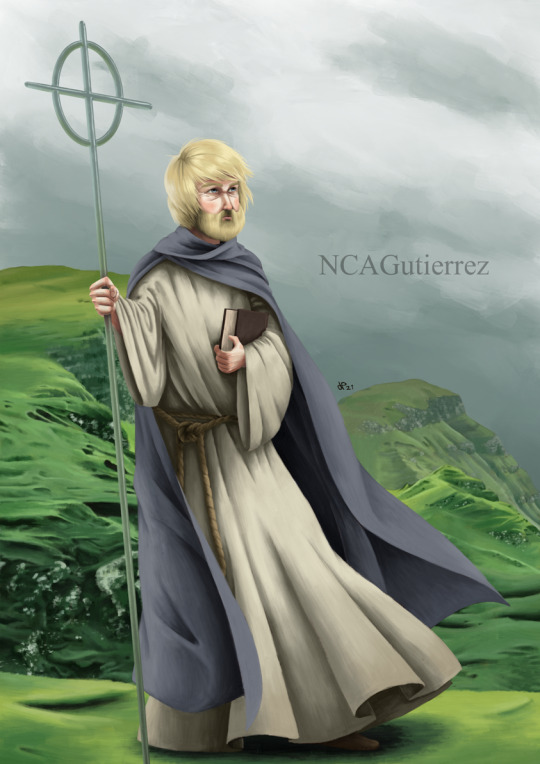
Finally I can share this commission I’ve been working on for the past three months!
I was commissioned by scottummz to paint St. Columba (aka St. Colmcille) some time ago, and now that it’s finished, I’m happy to say I succeeded in my first iconographic artwork XD
A lot of research had to be done, so I’m delighted to know he’s just as satisfied as I am. It was definitely a fun challenge.
#my art#artists on tumblr#Illustration#illust#Digital Illustration#digital drawing#digital art#krita#painting#st columba#st colmcille#christian iconography#mountains#saint#storm clouds#christiancore#scotland#Ireland#iconography
12 notes
·
View notes
Photo


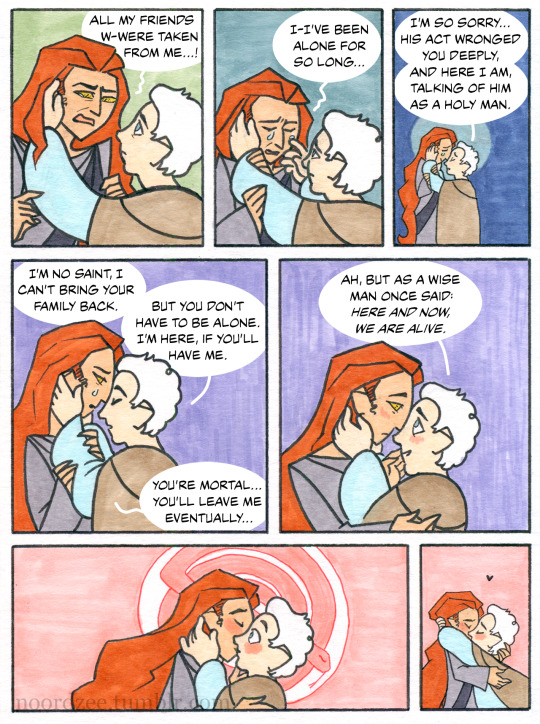
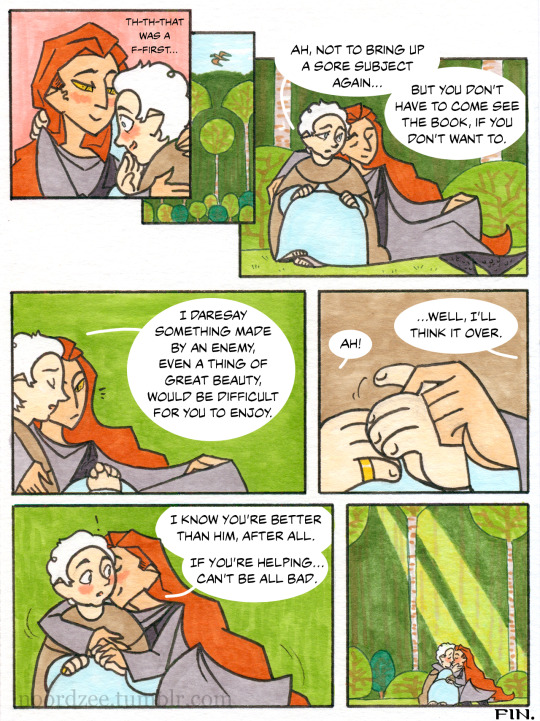
Someone pointed out in a tag on the previous sketchdump that there are no snakes in Ireland, making Crowley’s presence in my Secret of Kells AU as a snake fae ironic. I went “huh...! I think I could wring a plot out of that!”
(I’m sorry St Colmcille, I’m sure you were a lovely person and I know you didn’t actually banish the snakes from Ireland or fight a celtic god! But I got to thinking how wild an act like “banishing an entire species from their habitat” would really be, and how it would feel to be the only one left behind...)
I used copic markers on watercolor paper. Click for better quality! I’m a little embarrassed about how much work I put into this And Then They Kissed AU comic but I had fun so that’s what matters, right??
#good omens#the secret of kells#Secrets and Omens AU#illustration#artists on tumblr#comic#copic markers#fanart#long post#i....have more sketches of course#i'll collect them into another post soon but i wanted to get this comic finished and posted first#and i kept redoing it 'cuz it wasn't turning out just right#agh my scanner is so bad#it adds magenta and green artifacting to any black areas#aziraphale should be so much pinker#this was the best i could get by futzing with the Levels
4K notes
·
View notes
Text
WELL ROAD HAS A HOLY WELL
Legend has it that St. Colmcille took a Giant Step from the Round Tower and landed at the spot to where the Well is.
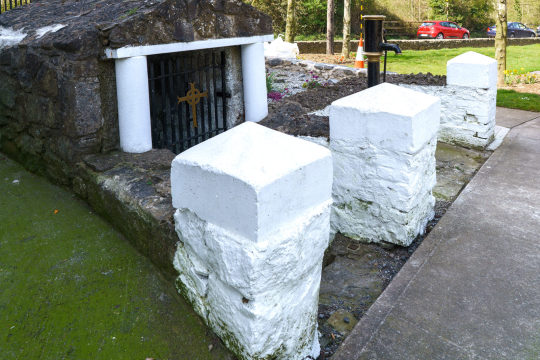
View On WordPress
0 notes